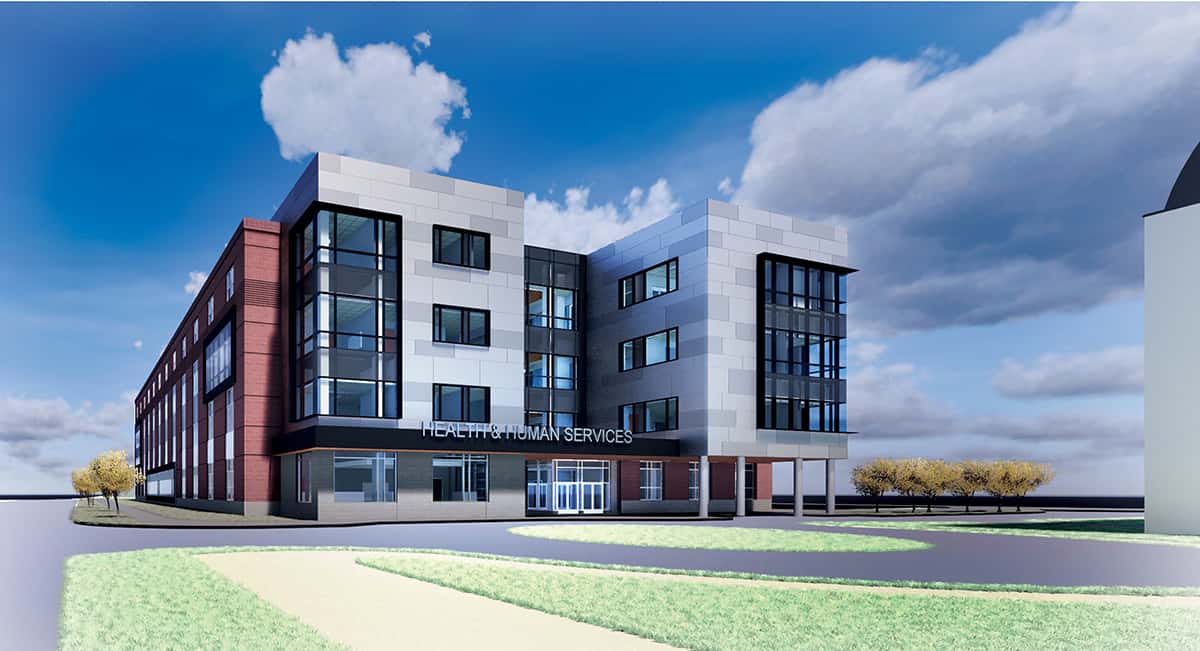Southern’s new College of Health and Human Services building, which breaks ground March 6, promises to boost interdisciplinary research and dramatically enhance the student experience across a variety of health-related fields.
The 4-story, 94,750-square-foot brick building, which will be located between Pelz Gymnasium and Fitch Street, will feature an abundance of natural light, collaborative spaces, state-of-the-art teaching and training spaces, lecture halls, a demonstration kitchen, and modern human performance laboratories.
“We are one of the major educational engines in this state,” said Sandra Bulmer, dean of the College of Health and Human Services. “Many of our health and human services programs have waitlists. This building is a manifestation of that need — to provide the best facility possible to prepare the best workforce possible.”
The building will house communication disorders; health and movement sciences (formerly exercise science); nursing; public health; and recreation, tourism and sport management. The Department of Social Work will remain in the historic Lang House, while the Marriage and Family Therapy Program will stay in Davis Hall
Until now, the departments resided in eight different buildings on campus. The new space “will finally enable them to be under one roof,” said Robert Sheeley, associate vice president for capital budgeting and facilities operations. “It is going to be an excellent addition to our campus.”
The university worked with Svigals + Partners for the exterior plans, and Little Diversified Architectural Consulting, a firm with vast experience in the health sciences, for the interior.
“The building will invite visitors to think about health and wellness. Stairs are a prominent, attractive feature on each floor, which we hope will encourage physical activity for those who are able,” Bulmer said. “We have also prioritized active learning spaces, natural light, and ergonomic furniture.”
A first floor “Main Street” is where the many student experiences, such as classes and advising, will take place. Departments will have their own dedicated spaces, but opportunities for cross-training, teaching and conversation are key to the building’s cost-effective design. For example, a single, centralized Interprofessional Collaboration and Meeting Center — with small hosteling office areas where adjunct faculty can work and meet with students — was created, instead of meeting rooms for each individual department.
Training spaces, such as a high-fidelity healthcare simulation center, will provide students with the latest technological capabilities and put them as close to real-life healthcare situations as possible. The center will be used to train students from nursing, communication disorders, recreation therapy, social work, athletic training, respiratory care, human performance, and public health.
“The high-fidelity healthcare simulation center is designed like a hospital floor,” Bulmer said. “Additionally, there are four standardized patient rooms that will allow us to have patient actors interacting with our student nurses and other health profession students. We will have a home simulation apartment to train students from multiple professions in home care.”
Videotaping capabilities within the center will allow students to better see what they are doing correctly or incorrectly and to view their patient interactions and debrief with faculty supervisors and other peers.
Departmental labs and clinics, currently used to train students and assist at-need populations in Connecticut, also will expand in size and capabilities in the new building.
“Our Communication Disorders Clinic currently serves 150 clients per week and provides a tremendous service to our community,” Bulmer said. “The new building will include updated and expanded clinic facilities that will allow us to serve more clients and train more graduate speech-language clinicians who can fill critical workforce shortages.”
Bulmer, who works closely with health industry professionals throughout the state, said these workforce shortages always have helped inform programmatic decisions; now they have served as a guide for the building’s design.
“This entire building has been designed to meet the needs of the workforce in Connecticut,” she said. “We know professionals are needed in these fields in this state. We take that very seriously. One of our goals is to increase our capacity to accept students into our many excellent programs, and these facility upgrades will be a significant step in moving in that direction.”
Paid for by state bond funds, the College of Health and Human Services building is expected to be completed in fall 2021, at a cost of $53 to $56 million.
Building features:
- 1st floor “Main Street,” where many student experiences, such as classes and academic advising, will take place
- State-of-the art healthcare simulation center fully outfitted with video capture technology:
- 6 simulated hospital rooms with high fidelity manikins, adjacent technology control rooms, nurses station, and medicine room
- 4 standardized patient rooms that will allow patient actors to interact with student nurses and other health professional students and have those sessions video streamed into debriefing classrooms
- home simulation apartment to train students from multiple professions in home care, also using patient actors
- 2 debriefing classrooms where student can view videotaped session to better see what they are doing correctly or incorrectly, view their patient interactions and consult with faculty supervisors and other peers
- 4 large nursing labs each with 6 beds, 6 exam tables, nursing equipment and technology, and a teaching presentation area that seats 16 students
- Human performance facility that will house Southern’s running injury clinic and include labs for training students and testing health and fitness, metabolism, neurophysiology, and biomechanics
- High-tech Bod Pod to measure body fat composition through air displacement
- Biomechanics lab with motion capture technology, high-tech treadmill, and the use of force plates for movement analysis
- Athletic training teaching laboratory
- Interprofessional collaboration and meeting center
- Communication Disorders teaching and research clinic where speech, language and hearing services will be provided to the community. All clinic rooms include adjoining observation areas for family members and/or student learners.
- Audiology research lab with sound booths for hearing testing and services
- Center for individuals with different abilities to have recreational opportunities that are supervised by graduate and undergraduate recreational therapy students
- Department offices and research spaces for faculty and staff
- Business presentation and collaboration classroom that seats 25 students
- Demonstration kitchen classroom that seats 40 students and will be used by the Department of Public Health for teaching nutrition, food safety, and healthy food preparation
- (2) 60-seat lecture halls that can be joined together to form a large auditorium


